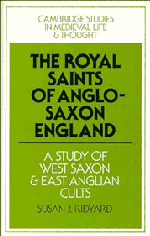Book contents
- Frontmatter
- Contents
- Dedication
- Acknowledgements
- List of abbreviations
- 1 The royal saints of Anglo-Saxon England: some problems of interpretation
- 2 The sources
- 3 Royal birth and the foundations of sanctity: theoretical interpretations
- 4 The cult of St Edburga at Winchester and Pershore
- 5 The children of Edgar
- 6 The royal cults of Ely
- 7 The cult of St Edmund
- 8 Piety, patronage and politics: towards an understanding of the Anglo-Saxon royal cults
- Appendix 1 The Life of St Edburga of Winchester by Osbert of Clare, prior of Westminster
- Appendix 2 Two items concerning St Edburga of Winchester from Oxford, Bodleian Library, MS Bodley 451
- Bibliography
- Index
8 - Piety, patronage and politics: towards an understanding of the Anglo-Saxon royal cults
Published online by Cambridge University Press: 11 May 2010
- Frontmatter
- Contents
- Dedication
- Acknowledgements
- List of abbreviations
- 1 The royal saints of Anglo-Saxon England: some problems of interpretation
- 2 The sources
- 3 Royal birth and the foundations of sanctity: theoretical interpretations
- 4 The cult of St Edburga at Winchester and Pershore
- 5 The children of Edgar
- 6 The royal cults of Ely
- 7 The cult of St Edmund
- 8 Piety, patronage and politics: towards an understanding of the Anglo-Saxon royal cults
- Appendix 1 The Life of St Edburga of Winchester by Osbert of Clare, prior of Westminster
- Appendix 2 Two items concerning St Edburga of Winchester from Oxford, Bodleian Library, MS Bodley 451
- Bibliography
- Index
Summary
Close to the heart of medieval Christianity stood the cult of the saints. As real presence and potent symbol, the saints occupied a central place within both church and community. Their cults, in theory founded upon divine acknowledgement, in fact created by man, fulfilled a complex series of functions, spiritual, social and political. The creators of those cults were men and women of great power: theirs was the ability to create the saints, if not in their own image at least in accordance with their own interests, and thereafter to pursue those interests through the manipulation of legend and cult. The present study has sought, by analysis of the identity, the beliefs and the actions of such creators – and of those who continued and adapted their work – to recover the history and function of a group of West Saxon and East Anglian royal cults. Focussing upon the three major problems of theoretical interpretation, historical explanation and continuity of cult, it has attempted to arrive at a new understanding of the place of the Angio-Saxon royal saint not only in pre–Conquest society but also in that of the Anglo-Norman realm.
At no point in the history of Anglo-Saxon England was it possible to expect or to assume royal sanctity. The Lives of the royal saints combine with the broader traditions of medieval political theory to demonstrate the weakness of the Chaney thesis which, portraying the saint king as the lineal descendant of the sacral king, makes sanctity an almost inevitable adjunct of birth into the ruling dynasties of Anglo-Saxon England.
- Type
- Chapter
- Information
- The Royal Saints of Anglo-Saxon EnglandA Study of West Saxon and East Anglian Cults, pp. 234 - 252Publisher: Cambridge University PressPrint publication year: 1989

